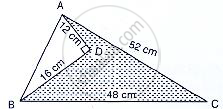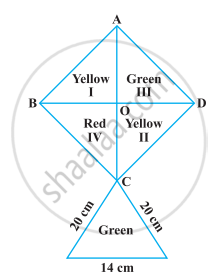Advertisements
Advertisements
Question
Using Heron’s formula, find the area of a triangle whose sides are 10 cm, 24 cm, 26 cm
Solution
Let a = 10 cm, b = 24 cm and c = 26 cm
s = `("a" + "b" + "c")/2`
= `(10 + 24 + 26)/2`
s = `60/2`
= 30 cm
s – a = 30 – 10 = 20 cm
s – b = 30 – 24 = 6 cm
s – c = 30 – 26 = 4 cm
Area of a triangle
= `sqrt("s"("s" - "a")("s" - "b")("s" - "c"))`
= `sqrt(30 xx 20 xx 6 xx 4)`
= `sqrt(2 xx 3 xx 5 xx 2^2 xx 5 xx 2 xx 3 xx 2^2)`
= `sqrt(2^6 xx 3^2 xx 5^2)`
= 23 × 3 × 5
= 8 × 3 × 5
= 120 cm2
Area of a triangle = 120 cm2
APPEARS IN
RELATED QUESTIONS
A triangle has sides 35 cm, 54 cm and 61 cm long. Find its area. Also, find the smallest of its altitudes ?
Find the area of the shaded region in the given figure.

A triangle and a parallelogram have the same base and the same area. If the sides of the triangle are 13 cm, 14 cm and 15 cm and the parallelogram stands on the base 14 cm, find the height of the parallelogram.
Find the area of a triangle whose base and altitude are 5 cm and 4 cm respectively.
The area of triangle formed by the points (− 5, 0), (0, – 5) and (5, 0) is
A man walks near a wall, such that the distance between him and the wall is 10 units. Consider the wall to be the Y-axis. The path travelled by the man is
Find the area of a triangle formed by the lines 3x + y – 2 = 0, 5x + 2y – 3 = 0 and 2x – y – 3 = 0
If the side of a rhombus is 10 cm and one diagonal is 16 cm, the area of the rhombus is 96 cm2.
A field in the form of a parallelogram has sides 60 m and 40 m and one of its diagonals is 80 m long. Find the area of the parallelogram.
How much paper of each shade is needed to make a kite given in the following figure, in which ABCD is a square with diagonal 44 cm.
